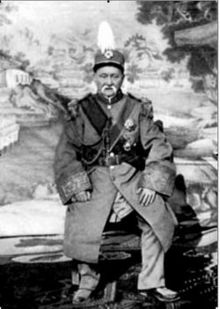

Ma Fuxing
馬福興 | |
|---|---|
 | |
| Tao-yin of Kashgar | |
| In office 1916–1924 | |
| Succeeded by | Ma Shaowu |
| Personal details | |
| Born | 1864 Yunnan |
| Died | 1924 Kashgar, Xinjiang |
| Nationality | Chinese |
| Political party | Xinjiang clique |
| Spouse | Harem of Wives |
| Children | Many |
| Military service | |
| Allegiance | |
| Years of service | 1916–1924 |
| Rank | Military commander |
| Unit | Kansu Braves, Kashgar Garrison |
| Commands | Military commander |
| Battles/wars | Boxer Rebellion, Xinhai Revolution in Xinjiang |
| |
| Ma Fuxing | |||||||||||
|---|---|---|---|---|---|---|---|---|---|---|---|
| Traditional Chinese | 馬福興 | ||||||||||
| Simplified Chinese | 马福兴 | ||||||||||
| |||||||||||
Ma Fuxing (Chinese: 馬福興; Ma Fu-hsing in Wade Giles; 1864–1924) was a Hui born in Yunnan, in Qing dynasty China. He was an ex-convict. During Yang Zengxin's reign in Xinjiang, Ma was appointed as a military commander, and then Titai of Kashgar.[1]
Ma Fuxing served as a general for the Qing dynasty. He joined the Kansu Braves during the Boxer Rebellion, under the command of Gen. Ma Fulu and fought against the foreign forces during the Siege of the International Legations (Boxer Rebellion) and Battle of Peking.[2]
After the fall of the Qing dynasty he started working for Yang Zengxin and recruited Dungan troops for him in 1911, and was posted in 1916 to Kashgar. In 1924 Yang intercepted some correspondence between Ma and the Zhili clique and became suspicious.[2]
Ma Fuxing was appointed as the commander of 2,000 Hui soldiers by Yang Zengxin.[3]

His reign was notorious for its repressiveness and his excesses. He kept a haremofUighur wives, and a hay cutting machine for severing the limbs of his victims.[4] The limbs were put on display, along with notices on why they were severed, on the city walls.[5] He also established government monopolies over industries such as petroleum, and made people purchase paraffin wax. In addition, he demanded that people call him padishah (meaning 'King').
Yang Zengxin decided that Ma's excesses were too great, and sent Ma Shaowu, another Hui military commander, to attack and replace him.[6] Ma Shaowu attacked Ma Fuxing, and then personally executed him by shooting him after receiving a telegram from Yang Zengxin. Ma Fuxing's body was tied to a cross to be put on display.[7] Ma Shaowu then was appointed Daotai of Kashgar.
This biographical article related to the military of China is a stub. You can help Wikipedia by expanding it. |
This Chinese religion-related biographical article is a stub. You can help Wikipedia by expanding it. |
This biographical article about a person notable in connection with Islam is a stub. You can help Wikipedia by expanding it. |
This article about a Chinese politician is a stub. You can help Wikipedia by expanding it. |